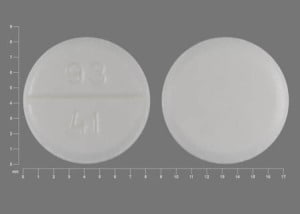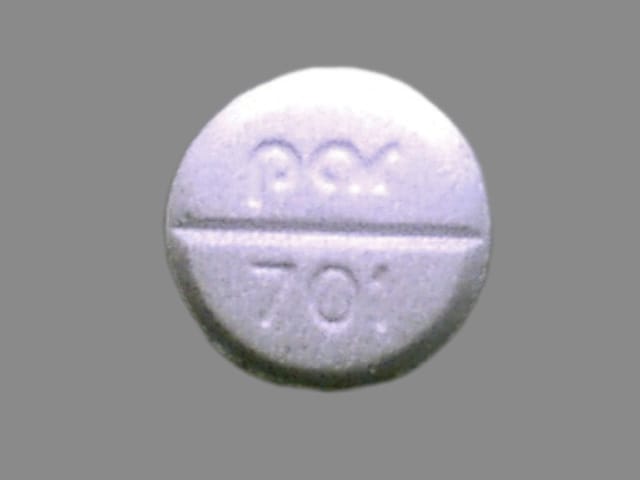Dosage Forms
Excipient information presented when available (limited, particularly for generics); consult specific product labeling.
Tablet, Oral, as citrate:
Generic: 50 mg
Pharmacology
Mechanism of Action
Clomiphene is a racemic mixture consisting of zuclomiphene (~38%) and enclomiphene (~62%), each with distinct pharmacologic properties. Clomiphene acts at the level of the hypothalamus, occupying cell surface and intracellular estrogen receptors (ERs) for longer durations than estrogen. This interferes with receptor recycling, effectively depleting hypothalamic ERs and inhibiting normal estrogenic negative feedback. Impairment of the feedback signal results in increased pulsatile GnRH secretion from the hypothalamus and subsequent pituitary gonadotropin (FSH, LH) release, causing growth of the ovarian follicle, followed by follicular rupture (ASRM 2013; Dickey 1996).
Pharmacokinetics/Pharmacodynamics
Absorption
Readily absorbed
Metabolism
Hepatic; undergoes enterohepatic recirculation (Goldstein 2000)
Excretion
Primarily feces (42%); urine (8%); some excretion may occur for up to 6 weeks after therapy is discontinued
Onset of Action
Ovulation: 5 to 10 days following course of treatment
Time to Peak
~6 hours (Goldstein 2000)
Duration of Action
Effects are cumulative; ovulation may occur in the cycle following the last treatment (Dickey 1996)
Half-Life Elimination
~5 days (Goldstein 2000)
Use: Labeled Indications
Treatment of ovulatory dysfunction: Treatment of ovulatory dysfunction in women desiring pregnancy
Contraindications
Hypersensitivity to clomiphene citrate or any of its components; liver disease or history of liver disease; abnormal uterine bleeding; enlargement or development of ovarian cyst (not due to polycystic ovarian syndrome); uncontrolled thyroid or adrenal dysfunction; presence of an organic intracranial lesion such as pituitary tumor; pregnancy
Canadian labeling: Additional contraindications (not in the US labeling): Hormone-dependent tumors (Clomid); thrombophlebitis, uterine fibroids, mental depression (Serophene)
Dosage and Administration
Dosing: Adult
Ovulation induction: Oral: Females: Note: Intercourse should be timed to coincide with the expected time of ovulation (usually 5 to 10 days after a clomiphene course).
Initial course: 50 mg once daily for 5 days. Begin on or about the fifth day of cycle if progestin-induced bleeding is scheduled or spontaneous uterine bleeding occurs prior to therapy. Therapy may be initiated at any time in patients with no recent uterine bleeding.
Dose adjustment: Subsequent doses may be increased to 100 mg once daily for 5 days only if ovulation does not occur at the initial dose. Lower doses (12.5 to 25 mg daily) may be used in women sensitive to clomiphene or who consistently develop large ovarian cysts (ASRM 2013).
Repeat courses: If needed, the 5-day cycle may be repeated as early as 30 days after the previous one. Exclude the presence of pregnancy. The lowest effective dose should be used.
Maximum dose: 100 mg once daily for 5 days for up to 6 cycles. Discontinue if ovulation does not occur after 3 courses of treatment; or if 3 ovulatory responses occur but pregnancy is not achieved. Long-term therapy (>6 cycles) is not recommended. Re-evaluate if menses does not occur following ovulatory response. Doses have ranged from 50 to 250 mg daily, although doses >100 mg daily have not been shown to increase pregnancy rates (ASRM 2013). The maximum recommended dose in women with PCOS is 150 mg daily (ESHRE/ASRM 2008).
Administration
The total daily dose should be taken at one time to maximize effectiveness (Dickey, 1996).
Storage
Store at room temperature of 15°C to 30°C (59°F to 86°F). Protect from light, heat, and excessive humidity.
ClomiPHENE Images
Drug Interactions
Ospemifene: Selective Estrogen Receptor Modulators may enhance the adverse/toxic effect of Ospemifene. Ospemifene may also enhance adverse/toxic effects of other Selective Estrogen Receptor Modulators. Selective Estrogen Receptor Modulators may diminish the therapeutic effect of Ospemifene. Ospemifene may also diminish the therapeutic effects of other Selective Estrogen Receptor Modulators. Avoid combination
Adverse Reactions
>10%: Endocrine & metabolic: Ovary enlargement (14%)
1% to 10%:
Central nervous system: Headache (1%)
Endocrine & metabolic: Hot flash (10%)
Gastrointestinal: Abdominal distention (≤6%), abdominal distress (≤6%), bloating (≤6%), nausea (≤2%), vomiting (≤2%)
Genitourinary: Breast disease (discomfort: 2%), abnormal uterine bleeding (1%)
Ophthalmic: Visual disturbance (2%)
<1%, postmarketing/case reports: Accommodation disturbance, acne vulgaris, alopecia, anxiety, arthralgia, back pain, cardiac arrhythmia, cataract, cerebrovascular accident, chest pain, constipation, depression, dermatitis, diarrhea, dizziness, dry hair, dyspnea, ectopic pregnancy, edema, endometriosis, endometrium disease (reduced thickness), erythema, erythema multiforme, erythema nodosum, eye pain, fatigue, fever, hepatitis, hypersensitivity reaction, hypertension, hypertrichosis, hypertriglyceridemia, increased appetite, increased serum transaminases, increased urine output, insomnia, irritability, leukocytosis, macular edema, migraine, mood changes, myalgia, neoplasm, nervousness, optic neuritis, ovarian cyst, ovarian hemorrhage, ovarian hyperstimulation syndrome, palpitations, pancreatitis, paresthesia, phlebitis, photopsia, pruritus, psychosis, pulmonary embolism, retinal hemorrhage, retinal thrombosis, retinal vascular spasm, seizure, severe abdominal pain, skin rash, syncope, tachycardia, thrombophlebitis, thyroid disease, tinnitus, urinary frequency, urticaria, uterine hemorrhage, vaginal dryness, vertigo, vision loss (temporary/prolonged), vitreous detachment (posterior), weakness, weight gain, weight loss
Warnings/Precautions
Concerns related to adverse effects:
- Hyperlipidemia: Women with, or a family history of, hyperlipidemia may be at increased risk of hypertriglyceridemia. High doses of clomiphene or long durations of therapy may increase risk this risk. Pancreatitis has been reported. Pretreatment screening of triglycerides is recommended.
- Ovarian enlargement: May be accompanied by abdominal distention or abdominal pain and generally regresses without treatment within a few days or weeks after therapy discontinuation. If ovaries are abnormally enlarged, withhold therapy until ovaries return to pretreatment size; reduce clomiphene dose and duration of future cycles.
- Ovarian hyperstimulation syndrome (OHSS): OHSS is a rare exaggerated response to ovulation induction therapy (Corbett 2014; Fiedler 2012). This syndrome may begin within 24 hours of treatment but may become most severe 7 to 10 days after therapy (Corbett 2014). Symptoms of mild/moderate OHSS may include abdominal distention/discomfort, diarrhea, nausea, and/or vomiting. Severe OHSS symptoms may include severe abdominal pain, anuria/oliguria, ascites, severe dyspnea, hypotension, or nausea/vomiting (intractable). Decreased creatinine clearance, hemoconcentration, hypoproteinemia, elevated liver enzymes, elevated WBC, and electrolyte imbalances may also be present (ASRM 2016; Corbett 2014; Fiedler 2012). Treatment is primarily symptomatic and includes fluid and electrolyte management, analgesics, and prevention of thromboembolic complications (ASRM 2016; SOGC-CFAS 2011).
- Visual disturbances: Blurring or other visual symptoms can occur; symptoms may increase with higher doses or duration of therapy and in some cases may be irreversible. These visual disturbances may render some activities to be more hazardous than normal (eg, operating machinery or driving). Patients with visual disturbances should discontinue therapy and receive prompt ophthalmic evaluation.
Disease-related concerns:
- Ovarian cancer: Prolonged use may increase the risk of borderline or invasive ovarian cancer.
- Polycystic ovarian syndrome (PCOS): Use with caution in patients unusually sensitive to pituitary gonadotropins (eg, PCOS); a lower dose may be necessary.
- Uterine fibroids: Use caution in patients with uterine fibroids, may cause further enlargement.
Other warnings/precautions:
- Appropriate use: To minimize risks, use only at the lowest effective dose for the shortest duration of therapy (especially for the first course of therapy). Women with PCOS, amenorrhea-galactorrhea syndrome, psychogenic amenorrhea, post oral contraceptive amenorrhea, and some cases of secondary amenorrhea of undetermined cause may most likely benefit from clomiphene therapy.
- Experienced physician: Use should be supervised by physicians who are thoroughly familiar with infertility problems and their management.
- Multiple births: May result from the use of this medication; advise patient of the potential risk of multiple births before starting the treatment.
Monitoring Parameters
Prior to therapy: serum estrogen. Rule out primary pituitary or ovarian failure, endometriosis/endometrial carcinoma, adrenal disorders, thyroid disorders, hyperprolactinemia, and male infertility. Serum triglycerides.
Pelvic exam prior to each course of therapy; pregnancy test prior to repeat courses; ovulation (may include serum estradiol, progesterone, urinary luteinizing hormone; ultrasound) (ASRM 2013).
OHSS: Monitoring of hospitalized patients should include abdominal circumference, albumin, cardiorespiratory status, electrolytes, fluid balance, hematocrit, hemoglobin, serum creatinine, urine output, urine specific gravity, vital signs, weight (daily or as necessary) and liver enzymes (weekly) (SOGC-CFAS 2011).
Pregnancy
Pregnancy Considerations
Use is contraindicated in females who are already pregnant.
The incidence of adverse fetal effects following maternal use of clomiphene for ovulation induction is similar to those seen in the general population.
Patient Education
What is this drug used for?
- It is used to help women get pregnant.
- It may be given to you for other reasons. Talk with the doctor.
Frequently reported side effects of this drug
- Hot flashes
Other side effects of this drug: Talk with your doctor right away if you have any of these signs of:
- Pancreatitis like severe abdominal pain, severe back pain, severe nausea, or vomiting.
- Severe dizziness
- Passing out
- DVT like swelling, warmth, numbness, change in color, or pain in the extremities.
- Vision changes
- Ovarian hyperstimulation syndrome like severe abdominal pain or bloating; severe nausea, vomiting, or diarrhea; excessive weight gain; shortness of breath; or change in amount of urine passed.
- Signs of a significant reaction like wheezing; chest tightness; fever; itching; bad cough; blue skin color; seizures; or swelling of face, lips, tongue, or throat.
Note: This is not a comprehensive list of all side effects. Talk to your doctor if you have questions.
Consumer Information Use and Disclaimer: This information should not be used to decide whether or not to take this medicine or any other medicine. Only the healthcare provider has the knowledge and training to decide which medicines are right for a specific patient. This information does not endorse any medicine as safe, effective, or approved for treating any patient or health condition. This is only a brief summary of general information about this medicine. It does NOT include all information about the possible uses, directions, warnings, precautions, interactions, adverse effects, or risks that may apply to this medicine. This information is not specific medical advice and does not replace information you receive from the healthcare provider. You must talk with the healthcare provider for complete information about the risks and benefits of using this medicine.







